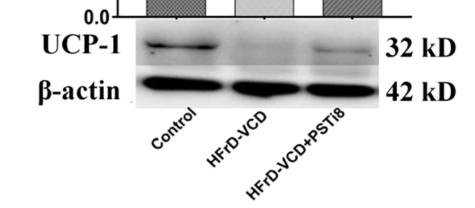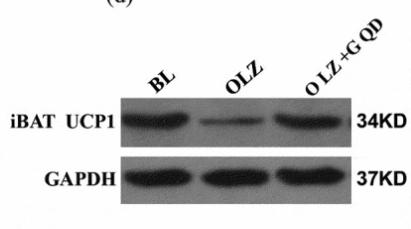| 产品: | UCP1 抗体 |
| 货号: | DF7720 |
| 描述: | Rabbit polyclonal antibody to UCP1 |
| 应用: | WB IHC |
| 反应: | Human, Mouse, Rat |
| 预测: | Bovine, Horse, Sheep, Rabbit, Dog |
| 分子量: | 34 kDa; 33kD(Calculated). |
| 蛋白号: | P25874 |
| RRID: | AB_2841189 |
产品描述
*The optimal dilutions should be determined by the end user.
*Tips:
WB: 适用于变性蛋白样本的免疫印迹检测. IHC: 适用于组织样本的石蜡(IHC-p)或冰冻(IHC-f)切片样本的免疫组化/荧光检测. IF/ICC: 适用于细胞样本的荧光检测. ELISA(peptide): 适用于抗原肽的ELISA检测.
引用格式: Affinity Biosciences Cat# DF7720, RRID:AB_2841189.
展开/折叠
mitochondrial brown fat uncoupling protein; Mitochondrial brown fat uncoupling protein 1; SLC25A7; Solute carrier family 25 member 7; Thermogenin; UCP 1; UCP; UCP1; UCP1_HUMAN; uncoupling protein 1 (mitochondrial, proton carrier); Uncoupling protein 1;
抗原和靶标
- P25874 UCP1_HUMAN:
- Protein BLAST With
- NCBI/
- ExPASy/
- Uniprot
MGGLTASDVHPTLGVQLFSAGIAACLADVITFPLDTAKVRLQVQGECPTSSVIRYKGVLGTITAVVKTEGRMKLYSGLPAGLQRQISSASLRIGLYDTVQEFLTAGKETAPSLGSKILAGLTTGGVAVFIGQPTEVVKVRLQAQSHLHGIKPRYTGTYNAYRIIATTEGLTGLWKGTTPNLMRSVIINCTELVTYDLMKEAFVKNNILADDVPCHLVSALIAGFCATAMSSPVDVVKTRFINSPPGQYKSVPNCAMKVFTNEGPTAFFKGLVPSFLRLGSWNVIMFVCFEQLKRELSKSRQTMDCAT
种属预测
score>80的预测可信度较高,可尝试用于WB检测。*预测模型主要基于免疫原序列比对,结果仅作参考,不作为质保凭据。
High(score>80) Medium(80>score>50) Low(score<50) No confidence
翻译修饰 - P25874 作为底物
| Site | PTM Type | Enzyme | Source |
|---|---|---|---|
| S51 | Phosphorylation | Uniprot | |
| Y55 | Phosphorylation | Uniprot | |
| T61 | Phosphorylation | Uniprot | |
| S250 | Phosphorylation | Uniprot | |
| T260 | Phosphorylation | Uniprot | |
| T265 | Phosphorylation | Uniprot |
研究背景
Mitochondrial protein responsible for thermogenic respiration, a specialized capacity of brown adipose tissue and beige fat that participates to non-shivering adaptive thermogenesis to temperature and diet variations and more generally to the regulation of energy balance (By similarity). Functions as a long-chain fatty acid/LCFA and proton symporter, simultaneously transporting one LCFA and one proton through the inner mitochondrial membrane. However, LCFAs remaining associated with the transporter via their hydrophobic tails, it results in an apparent transport of protons activated by LCFAs. Thereby, dissipates the mitochondrial proton gradient and converts the energy of substrate oxydation into heat instead of ATP. Regulates the production of reactive oxygen species/ROS by mitochondria (By similarity).
May undergo sulfenylation upon cold exposure. May increase the sensitivity of UCP1 thermogenic function to the activation by noradrenaline probably through structural effects.
May undergo ubiquitin-mediated proteasomal degradation.
Mitochondrion inner membrane>Multi-pass membrane protein.
Brown adipose tissue.
Most probably functions as a monomer. Binds one purine nucleotide per monomer (By similarity). However, has also been suggested to function as a homodimer or a homotetramer. Tightly associates with cardiolipin in the mitochondrion inner membrane; may stabilize and regulate its activity.
Belongs to the mitochondrial carrier (TC 2.A.29) family.
研究领域
· Environmental Information Processing > Signal transduction > Apelin signaling pathway. (View pathway)
· Human Diseases > Neurodegenerative diseases > Huntington's disease.
· Organismal Systems > Endocrine system > PPAR signaling pathway.
文献引用
Application: WB Species: Rat Sample:
Application: WB Species: Rat Sample:
Application: WB Species: Mice Sample: adipose tissue
限制条款
产品的规格、报价、验证数据请以官网为准,官网链接:www.affbiotech.com | www.affbiotech.cn(简体中文)| www.affbiotech.jp(日本語)产品的数据信息为Affinity所有,未经授权不得收集Affinity官网数据或资料用于商业用途,对抄袭产品数据的行为我们将保留诉诸法律的权利。
产品相关数据会因产品批次、产品检测情况随时调整,如您已订购该产品,请以订购时随货说明书为准,否则请以官网内容为准,官网内容有改动时恕不另行通知。
Affinity保证所销售产品均经过严格质量检测。如您购买的商品在规定时间内出现问题需要售后时,请您在Affinity官方渠道提交售后申请。产品仅供科学研究使用。不用于诊断和治疗。
产品未经授权不得转售。
Affinity Biosciences将不会对在使用我们的产品时可能发生的专利侵权或其他侵权行为负责。Affinity Biosciences, Affinity Biosciences标志和所有其他商标所有权归Affinity Biosciences LTD.



